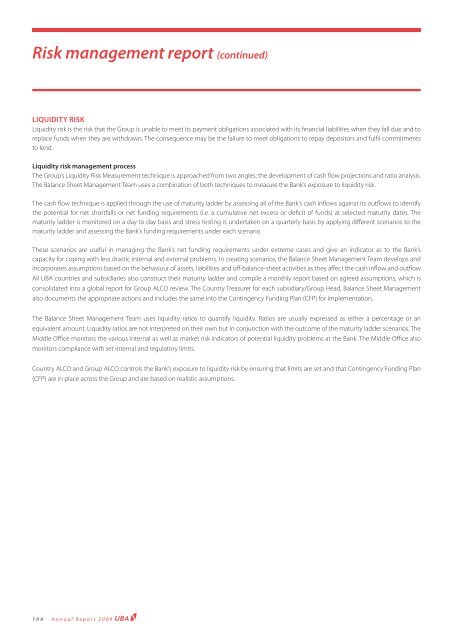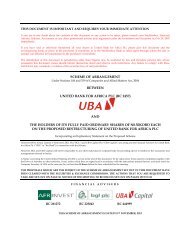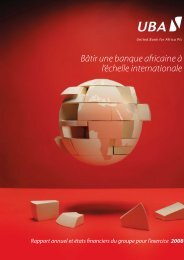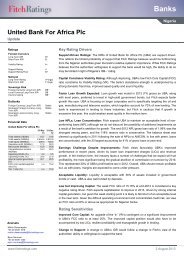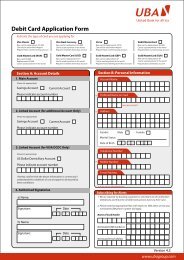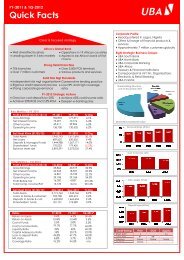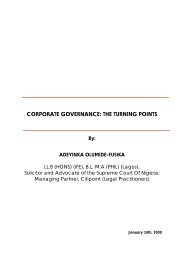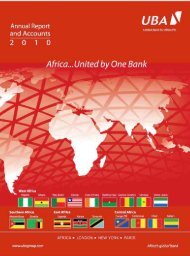2009 Annual Report and Financial Statements - UBA Plc
2009 Annual Report and Financial Statements - UBA Plc
2009 Annual Report and Financial Statements - UBA Plc
You also want an ePaper? Increase the reach of your titles
YUMPU automatically turns print PDFs into web optimized ePapers that Google loves.
Risk management report (continued)<br />
LIQUIDITY RISK<br />
Liquidity risk is the risk that the Group is unable to meet its payment obligations associated with its fi nancial liabilities when they fall due <strong>and</strong> to<br />
replace funds when they are withdrawn. The consequence may be the failure to meet obligations to repay depositors <strong>and</strong> fulfi l commitments<br />
to lend.<br />
Liquidity risk management process<br />
The Group’s Liquidity Risk Measurement technique is approached from two angles; the development of cash fl ow projections <strong>and</strong> ratio analysis.<br />
The Balance Sheet Management Team uses a combination of both techniques to measure the Bank’s exposure to liquidity risk.<br />
The cash fl ow technique is applied through the use of maturity ladder by assessing all of the Bank’s cash infl ows against its outfl ows to identify<br />
the potential for net shortfalls or net funding requirements (i.e. a cumulative net excess or defi cit of funds) at selected maturity dates. The<br />
maturity ladder is monitored on a day to day basis <strong>and</strong> stress testing is undertaken on a quarterly basis by applying diff erent scenarios to the<br />
maturity ladder <strong>and</strong> assessing the Bank’s funding requirements under each scenario.<br />
These scenarios are useful in managing the Bank’s net funding requirements under extreme cases <strong>and</strong> give an indicator as to the Bank’s<br />
capacity for coping with less drastic internal <strong>and</strong> external problems. In creating scenarios, the Balance Sheet Management Team develops <strong>and</strong><br />
incorporates assumptions based on the behaviour of assets, liabilities <strong>and</strong> off -balance-sheet activities as they aff ect the cash infl ow <strong>and</strong> outfl ow<br />
All <strong>UBA</strong> countries <strong>and</strong> subsidiaries also construct their maturity ladder <strong>and</strong> compile a monthly report based on agreed assumptions, which is<br />
consolidated into a global report for Group ALCO review. The Country Treasurer for each subsidiary/Group Head, Balance Sheet Management<br />
also documents the appropriate actions <strong>and</strong> includes the same into the Contingency Funding Plan (CFP) for implementation.<br />
The Balance Sheet Management Team uses liquidity ratios to quantify liquidity. Ratios are usually expressed as either a percentage or an<br />
equivalent amount. Liquidity ratios are not interpreted on their own but in conjunction with the outcome of the maturity ladder scenarios. The<br />
Middle Offi ce monitors the various internal as well as market risk indicators of potential liquidity problems at the Bank. The Middle Offi ce also<br />
monitors compliance with set internal <strong>and</strong> regulatory limits.<br />
Country ALCO <strong>and</strong> Group ALCO controls the Bank’s exposure to liquidity risk by ensuring that limits are set <strong>and</strong> that Contingency Funding Plan<br />
(CFP) are in place across the Group <strong>and</strong> are based on realistic assumptions.<br />
104<br />
<strong>Annual</strong> <strong>Report</strong> <strong>2009</strong>


